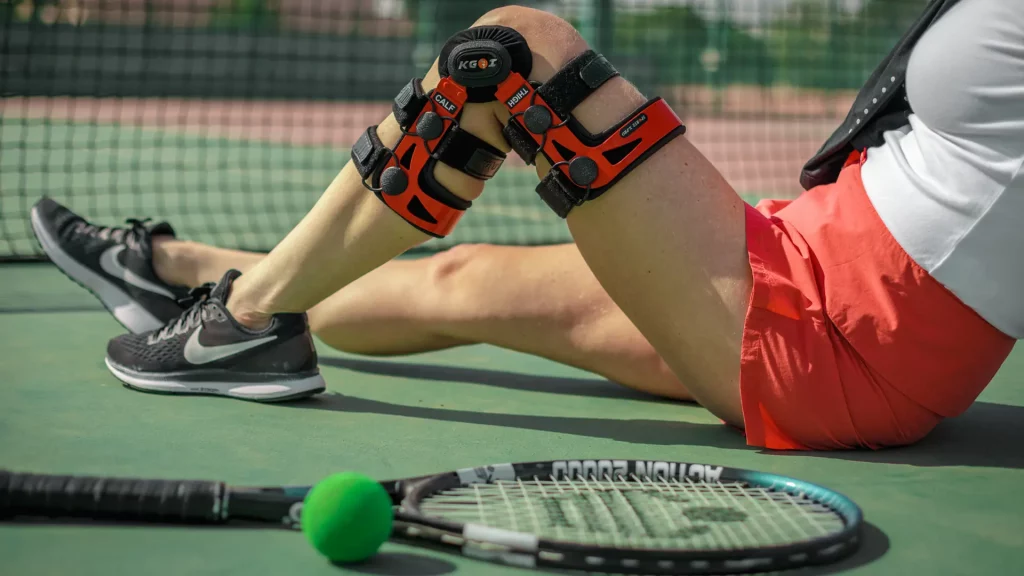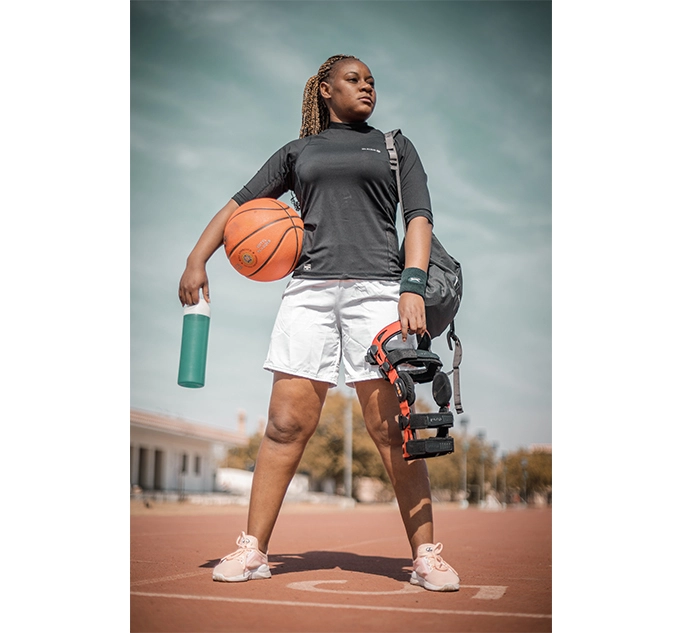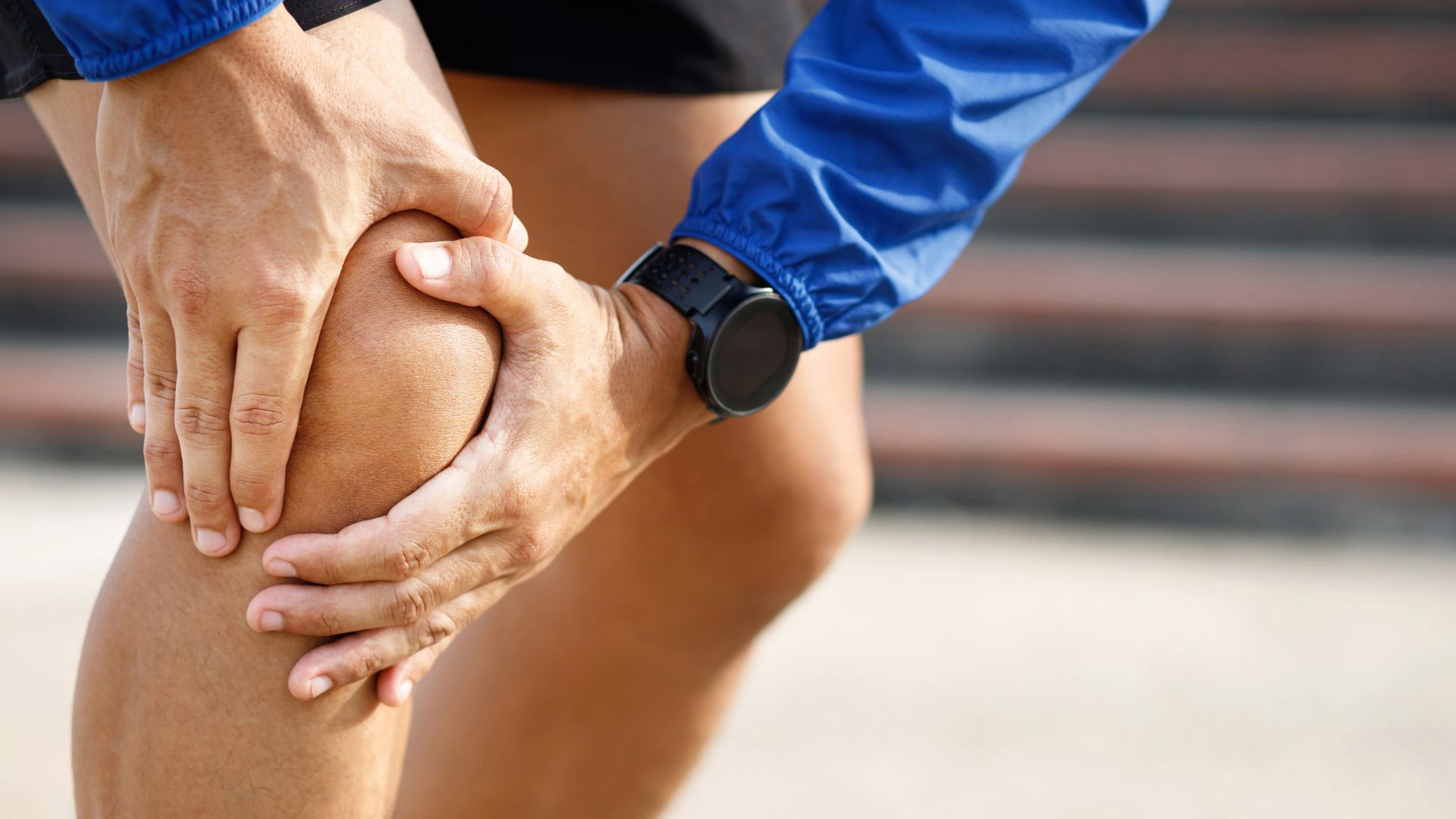Knee pain is a familiar foe that can sideline even the most passionate runners and athletes, halting the joy of a morning jog or an intense workout session. It’s something we’ve faced personally, so we understand just how frustrating it can be.
Discovering that knee braces could allow us to run without wincing in pain was a game-changer for us. That’s why we’re excited to share our findings on how these supports can help you maintain your stride with less discomfort.
In our upcoming blog post, we’ll dive into everything you need to know about knee braces designed specifically for runners and athletes – from compression sleeves that hug your joint snugly to stabilizers that provide the extra support needed for those longer runs.
Choosing the right kind of knee brace can feel overwhelming, but don’t worry; we’ve got you covered with tips on finding one that meets your needs perfectly. Because when it comes to staying active and pursuing what makes you happy, having strong, supported knees is essential.
Stay tuned for insights on how to keep your knees healthy and pain-free!
Key Takeaways
- Knee braces reduce pain and help heal injuries for runners and athletes. They come in different types to fit specific needs.
- Proper fit and the right type of knee brace can prevent future injuries. Consult a healthcare provider for advice on the best option.
- Wearing a knee brace during activities like running supports the knee joint. It helps keep athletes active without fear of injury.

Sportz X-pro ACL Knee Brace
How Knee Injuries Affect Runners and Athletes
Knee injuries can hurt runners and athletes a lot. They can slow us down and make it hard to perform at our best.
Common knee injuries
Common knee injuries often affect runners and athletes. One frequent issue is patellar tendonitis. This happens when the tendon below the kneecap gets inflamed. It causes pain in the front of the knee.
Athletes need support for this type of injury.
Another common problem is a meniscus tear. This injury occurs when the cartilage in the knee gets damaged. It can happen during twisting movements. A meniscus injury may lead to swelling and difficulty moving the knee.
Runners often seek a knee brace for meniscus injury to help stabilize their knee.
Lastly, patellofemoral syndrome is a concern for many athletes. This condition causes pain around the kneecap. It usually arises from overuse or muscle imbalances. Knee support for athletes can relieve pain and provide stability.
Proper support is vital to keep us active and prevent future injuries.
Next, we will discuss the impact of these injuries on performance.
Impact on performance
Knee injuries can hurt our performance. Pain and swelling make it hard to run or play sports. This can lead to fewer workouts and less practice. When we wear knee braces, we can reduce pain.
They help us stay active without worrying about our knees. This makes a big difference in how we perform.
Knee stability is key for athletes. Knee braces provide support and keep our knees stable during action. Proper support can help us run faster and jump higher. Injuries can keep us off the track for a long time.
Knee braces help prevent this problem, allowing us to keep going strong. We can enjoy our favorite sports without the fear of injury.
Need for proper support
Proper support is vital for runners and athletes. Knee braces help us minimize pain and swelling. They stabilize our knees during high-impact activities. This support allows us to keep running without pain.
We can avoid injuries that could sideline us. Wearing a knee brace for running can make a big difference. For those with issues like arthritis or meniscus problems, finding the right knee support is crucial.
A good knee brace can prevent future injuries and keep us active for years to come.
Benefits of Wearing a Knee Brace
Knee braces help reduce pain and stiffness in our knees. They support movement and healing while also preventing future injuries.
Reduces pain and stiffness
Knee braces for runners and athletes play a crucial role in reducing pain and stiffness. Wearing a knee brace helps to stabilize the joint. This support can minimize swelling after running or engaging in high-impact sports.
We often find that knee compression sleeves provide relief during our workouts. Many of us have experienced discomfort, and having the right support makes a big difference.
We notice that knee braces help to keep our knees warm. This warmth can reduce stiffness, making it easier to move. A good fit is key, as a snug brace will support our movements effectively.
In our experience, those with knee pain, like patellar tendonitis, benefit greatly from using knee braces, such as patellar tendonitis braces for runners.
The right knee support allows us to continue running without pain. With proper care and support, we can stay active and enjoy our sports for years. Our next focus is on the types of knee braces that will give us the best support during our activities.
Supports movement and healing
A knee brace not only reduces pain and stiffness but also supports movement and healing. We feel the difference when we wear one during our runs. These braces keep our knees stable.
This stability allows us to move more freely without the fear of injury.
Wearing a knee brace helps to decrease swelling. As a result, our knees recover faster. Runners, who suffer from conditions like patellar tendonitis, can find relief with a supportive brace.
These devices push us toward a quicker healing process. With proper support, we can maintain our performance and keep running pain-free.
Knee braces also play a vital role in injury prevention. They provide the necessary joint support needed during high-impact activities. This support helps us stay active and continue our favorite sports.
We can enjoy our activities while minimizing the risk of further knee pain or injuries.
Prevents future injuries
Knee braces help prevent future injuries for runners and athletes. They support the knee and keep it stable. This support is crucial during high-impact activities. We can reduce the chance of pain and swelling by wearing a brace.
Many athletes use knee straps and compression sleeves for added protection. They help us stay active without the fear of injury. Finding the right knee brace matters, especially for those with conditions like patellar tendonitis or arthritis.
Proper support allows us to continue running pain-free for years.

Elite ACL Knee Brace
Types of Knee Braces for Runners and Athletes
We can find many types of knee braces made for runners and athletes. Some have side stabilizers to keep the knee steady. Others use gel pads to protect the kneecap. There are also compression sleeves that help with support and blood flow.
Each type has its own benefits, which we will explore further in this article.
Brace with side stabilizers
A knee brace with side stabilizers offers extra support for our knees. These stabilizers help keep the knee joint steady. They can reduce pain and swelling during sports and running.
This type of brace is especially helpful for runners facing knee pain or injuries.
We often experience knee pain from activities like running. A brace with side stabilizers can make a difference. It provides the stability we need while moving. This support allows us to continue our activities with less discomfort.
Finding the right knee brace is essential. It should fit well and feel comfortable. A knee stabilizer can be an excellent choice for athletes. It helps prevent injuries and supports healing.
Many runners benefit from using these braces to stay active and pain-free.
Brace with patella gel pads
Moving on from the brace with side stabilizers, we can look at the brace with patella gel pads. This type of knee brace is a great choice for runners and athletes. It offers extra cushioning around the kneecap.
This helps reduce pain and discomfort during activities.
The gel pads support the patella, easing pressure on the knee joint. This is especially helpful for conditions like patellar tendonitis or patellofemoral syndrome. We have seen how this type of brace can help athletes stay active.
The added support encourages healing and improves knee stability.
Wearing a knee brace with gel pads can make a big difference. It can help runners push through their workouts with less pain. Finding the right fit is key. We should always seek advice from healthcare providers to choose the best option for knee pain relief.
Compression braces
Compression braces are a popular choice for runners and athletes. They help reduce pain and swelling from running and other high-impact activities. These braces support knee stability for athletes while keeping the knee warm.
Many of us have found that wearing a compression knee sleeve for running can improve comfort during workouts. They can also aid in recovery after intense exercise.
Compression braces offer support for conditions like patellar tendonitis and patellofemoral syndrome. They work by providing gentle pressure around the knee. This pressure helps to minimize discomfort and assists in the healing process.
A compression brace is easy to wear and can be adjusted for a snug fit. Let’s explore how to choose the right knee brace next.
How to Choose the Right Knee Brace
To choose the right knee brace, we need to think about our injury. We should focus on comfort and fit as well.
Consider the type and severity of injury
Choosing the right knee brace starts with understanding the type and severity of our injury. Different injuries need different types of support. For example, runners with patellar tendonitis may benefit from a patellar tendonitis brace.
Those with ACL or PCL injuries might need a more rigid knee stabilizer for running. Each brace is made for specific issues, so it’s essential to match the brace to our needs.
We also need to think about how serious our injury is. A mild injury might only require a simple knee sleeve. However, a severe injury could need a more advanced brace with side stabilizers.
Healthcare providers can help us find the best option. With proper support, we can relieve knee pain and keep running safely. Runners and athletes must pay attention to these details for the best results.
Look for adjustability and comfort
Next, we should focus on adjustability and comfort in a knee brace. Finding a knee brace that fits well is key. An adjustable brace allows us to change the fit based on our needs. Comfort matters, especially when we are active.
A brace that fits snugly without being too tight offers better support.
We can also look for features like padding. Padding helps reduce pain and stiffness during our runs. Many options are available, including athletic knee compression sleeves and knee braces for sports.
It’s smart to try on different braces to see which feels best.
Consulting with a healthcare provider can help us find the right fit. They can guide us in selecting a knee brace that meets our specific needs. We have our own unique challenges, so the best support will vary for each of us.
Consult a medical professional
Consulting a medical professional is crucial for those dealing with knee pain. They can help us choose the right knee brace for sports and based on our injury’s type and severity. A healthcare provider can give us advice on the best options, like knee supports for patellar tendonitis or ACL and PCL support for runners.
We want to ensure the right fit and purpose in our knee braces. Each brace serves different needs, whether we face patellofemoral syndrome or just need running knee compression. Seeking guidance can make a big difference in our performance and comfort during activities.
Tips for Using Knee Braces During Activity
Using a knee brace during activity can help us stay safe. We should ensure it fits well and is in the right place on our knee.
Proper fitting and positioning
Proper fitting and positioning of knee braces are vital for athletes and runners. A knee brace needs to fit snugly. It should stay in place without sliding down or pinching the skin.
We must ensure the brace covers the injured area properly. This gives the best support and stability. A loose brace will not help as much. It can even cause more issues.
We should adjust the straps to find the right fit. This helps keep the brace secure during activity. We also have to check how it feels while running. If it feels uncomfortable or restricts movement, we may need to reposition it.
Knee braces, like patellar tendonitis braces for runners, also need to be worn correctly. This ensures we get the right knee pain relief for runners and athletes.
Gradually increase use
After ensuring proper fitting and positioning, we can focus on gradually increasing use of the knee brace. Starting with short periods is wise. This allows our knee to adjust comfortably.
We should listen to our bodies. If we feel pain or discomfort, it’s essential to take a step back.
As we become more comfortable, we can slowly add more time wearing the brace. This helps build strength in the knee while gaining support. Knee braces are crucial for athletes. They protect against injuries like patellar tendonitis and patellofemoral syndrome.
Finding the right fit can make a big difference in our performance. With patience, we can enjoy running again without fear of pain.
Listen to your body
Listening to our bodies is key when we wear knee braces. Signs like pain or discomfort tell us to adjust how we use them. Knee braces provide crucial support for running and high-impact sports.
They help minimize pain and swelling from activities. Taking breaks is important. We should not push through sharp pain. Doing so may lead to more serious knee injuries.
Each of us is different, and our needs change. Finding the right knee support for running helps prevent injuries. We must pay attention to our body’s messages. Comfortable and well-fitted braces support movement and healing.
This keeps us active and running pain-free for years to come.
Conclusion
Knee braces are vital for runners and athletes. They provide the support we need to keep moving. Using a knee brace can reduce pain and help us heal. Choosing the right brace is key to injury prevention.
Seek advice from a healthcare provider to find what fits best.
What steps will we take to protect our knees? Let’s ensure we have the right gear for a successful run. Taking care of our knees can lead to better performance. Together, we can enjoy running without pain.
Get out there and stay active!



